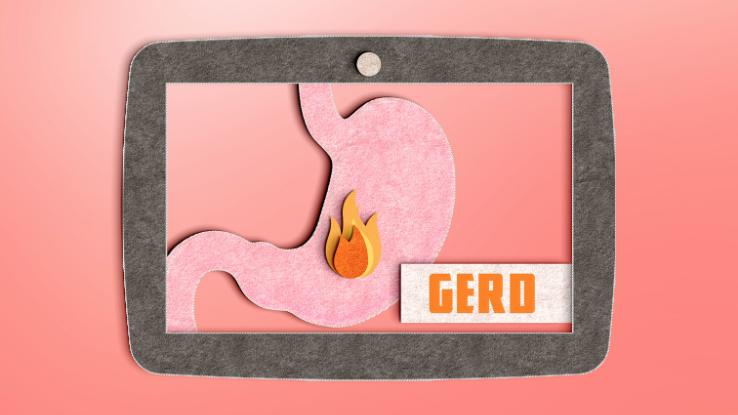Gastroesophageal Reflux Disease (GERD): Symptoms, Diagnosis and Treatment

Commonly known as GERD, gastroesophageal reflux disease is a chronic disease that occurs as a result of persistent acid reflux, which, in turn, occurs when stomach acid flows back up from the stomach into the esophagus. In some cases, bile may flow into the esophagus as well. Most often, many of the uncomfortable and painful signs and symptoms of GERD are caused by the backwash of acid irritating the lining of the esophagus.
What Are the Differences Between Acid Reflux, Heartburn and GERD?
Acid reflux, also known commonly as “heartburn,” is sometimes confused with GERD. Acid reflux is the term used to describe the intermittent symptoms of heartburn — i.e. a burning pain in the chest and throat — which occur typically after eating. On the other hand, GERD is a chronic condition that can develop if acid reflux occurs regularly and is left untreated.

What Are the Symptoms of GERD?
Symptoms of GERD are similar to symptoms of acid reflux, but they occur more frequently and over a longer period of time. These may include:

- Heartburn
- Reflux of stomach acid or partially digested food into the mouth
- An unpleasant, often sour, taste in the mouth
- Cough
- Pain in the center of the chest, behind the sternum
- Difficulty swallowing
- Feeling as though there is a lump in the throat
- Feeling as though there is food stuck behind the breastbone
- Nausea after eating
- Hiccups
- Sore throat
- Hoarseness or changes in the voice
- Halitosis (bad breath)
- Dental problems
Causes and Risk Factors Associated With GERD
The main cause of GERD is the malfunction of the lower esophageal sphincter (LES) to close after a person has eaten. The LES is a ring of muscle fibers around the top of the stomach, which opens to allow food to be swallowed, and should close after swallowing to prevent backflow. If this sphincter doesn’t close correctly, food can leak back into the esophagus along with stomach acid or bile. GERD occurs when someone’s LES continues to fail in preventing acid reflux from occurring, thus making it a chronic condition.

There are several key risk factors which increase the chances of an individual having GERD, including:
- Obesity
- Pregnancy
- Smoking
- Connective tissue diseases, such as scleroderma
- Hiatus hernia
- Asthma
- Diabetes
- Zollinger-Ellison syndrome
- Delayed stomach emptying
Additionally, taking certain medications, such as painkillers, steroids, blood pressure medications, antidepressants, hormone therapies, and anticholinergics, can increase one’s chance of having GERD.
How to Prevent GERD
It’s important to help prevent this condition from developing since it can lead to serious complications, including esophageal ulcers and an increased risk of esophageal cancer. Some of the best ways to prevent GERD are to make lasting lifestyle changes, including:

Maintain a Healthy Weight: Obesity is a leading cause of GERD because too much weight adds pressure to the abdomen and increases the risk of acid reflux occurring. Those who need to lose weight should aim to lose 1 to 2 pounds a week until they have reached their target weight.
Avoid Certain Foods and Drinks: Some food and drinks trigger heartburn and increase your risk of developing GERD. Chocolate, mint, garlic, onion, alcohol, tomato sauce, caffeinated drinks and fatty and fried food are all common triggers. Pay attention to what triggers heartburn for you personally since some people may have different triggers than others.
Eat Smaller Meals: By avoiding overeating, you can decrease the risk of acid reflux and GERD.
Don’t Wear Tight Clothes: When your clothes fit tightly, it can add pressure to your abdomen and make it more likely that acid reflux will occur.
Quit Smoking: If you smoke, your lower esophageal sphincter is less likely to function properly, increasing your risk for GERD.
Don’t Lie Down After Eating: Try to wait for at least two to three hours before lying down or going to bed.
Elevate Your Head While Sleeping: Many people are more likely to experience heartburn at night or when they go to bed. To counteract this, raise the feet of the bed under your head by about 6 to 9 inches. You can also purchase special wedges which can be placed between the mattress and the box spring.
Additionally, try avoiding medications (listed above) that may increase your chance of having GERD.
Diagnosing GERD
GERD can be diagnosed clinically based on your symptoms. However, your doctor may wish to request further investigations to rule out more serious conditions. Common tests include:

Barium Swallow: This test involves being asked to swallow liquid barium while x-ray images are taken. The Barium shows up on the x-ray images and can be tracked as you swallow. A barium test may reveal damage to the esophagus such as strictures or ulcers, malfunctioning of the esophageal sphincter, or the presence of a hiatus hernia.
Endoscopy: Some people, especially patients who have already been diagnosed with GERD or acid reflux, will need to undergo a specialized endoscopy called an esophagogastroduodenoscopy (EGD). This test uses a thin flexible scope with a camera on the end to visually inspect the mouth, throat, esophagus, stomach and small intestine. You are usually sedated or asleep for the procedure. An EGD can help explain the extent of damage to the digestive tract.
Biopsy: A biopsy may be required to detect certain kinds of inflammation, cell disorders, and pre-cancers. Barrett’s esophagus, a tissue disorder that occurs when tissue that lines the intestine replaces the tissue that lines the esophagus, can be diagnosed using a biopsy. A biopsy is taken at the same time as endoscopy, and you will not feel it.
Esophageal Manometry: Esophageal manometry is used to identify whether the sphincter at the top of the stomach is functioning properly. This test measures sphincter pressure to determine whether the connection between the esophagus and stomach is opening and closing properly.
Common GERD Treatments
GERD is usually managed by a combination of lifestyle changes and medication. The following medications may be used:

Antacids: These neutralize stomach acid to provide relief for heartburn. However, constipation and wind are fairly common side effects.
Medications to Reduce Acid Production: These medications are called H2 receptor blockers, and examples include ranitidine (Zantac) and famotidine (Pepcid AC). These may also be available in prescription form.
Medications to Block Acid Production: These medications are called proton pump inhibitors and may also help the esophagus to heal. Examples include lansoprazole (Prevacid) and omeprazole (Prilosec). These may also be available in prescription form.
Prokinetic Medication: This includes bethanechol (Urecholine) or Metoclopramide (Reglan) and may be used to help the stomach empty faster and tighten the valve between the esophagus and the stomach. However, side effects like depression, anxiety and fatigue may prevent some individuals from using them.
If medications and lifestyle changes are not effective in treating GERD, surgery may be required. Surgical treatments include Nissen fundoplication, an abdominal operation where the top part of the stomach is moved to strengthen the sphincter in order to prevent symptoms and can also fix a hiatal hernia. Another similar surgery is a transoral incisionless fundoplication (TIF), where the surgeon accesses the top of the stomach via endoscopy through the mouth, so has the advantage of not requiring an abdominal incision.
If left untreated, GERD (or acid reflux) can cause complications for one’s respiratory system, throat and mouth. Additionally, chronic cough, hoarseness, asthma, dental problems, damaged teeth, and sinus problems may occur if left untreated. Chronic or persistent GERD, if left untreated, can eventually cause long-term injury, such as a narrowed or scarred esophagus.
In serious cases, the tissue lining the esophagus can become precancerous; this condition is known as Barrett’s esophagus. In Barrett’s esophagus normal esophageal lining becomes damaged and replaced with a lining that is more similar to that of the intestines. Those with Barrett’s esophagus are 30 times more likely to develop a type of esophageal cancer known as esophageal adenocarcinoma. The American Gastroenterological Association recommends that people with multiple risk factors for this kind of cancer should be screened for Barrett’s esophagus. Risk factors include:
- Age >50
- Male
- Caucasian
- Chronic GERD
- Hiatus hernia
- Overweight/obese
If you are worried you may fall into these risk categories, ask your doctor if you should be screened.
Resource Links:
- Medline Plus (2021). Gastroesophageal reflux disease.
- Mayo Clinic (2020). Gastroesophageal reflux disease.
- NHS (2020). Heartburn and acid reflux.
- National Institute of Diabetes and Digestive and Kidney Diseases (2020). Acid Reflux (GER & GERD) in Adults.
- BMJ Best Practice (2020). Patient Information: Heartburn.
- NHS Inform (2020). Gastro-oesophageal reflux disease (GORD).





